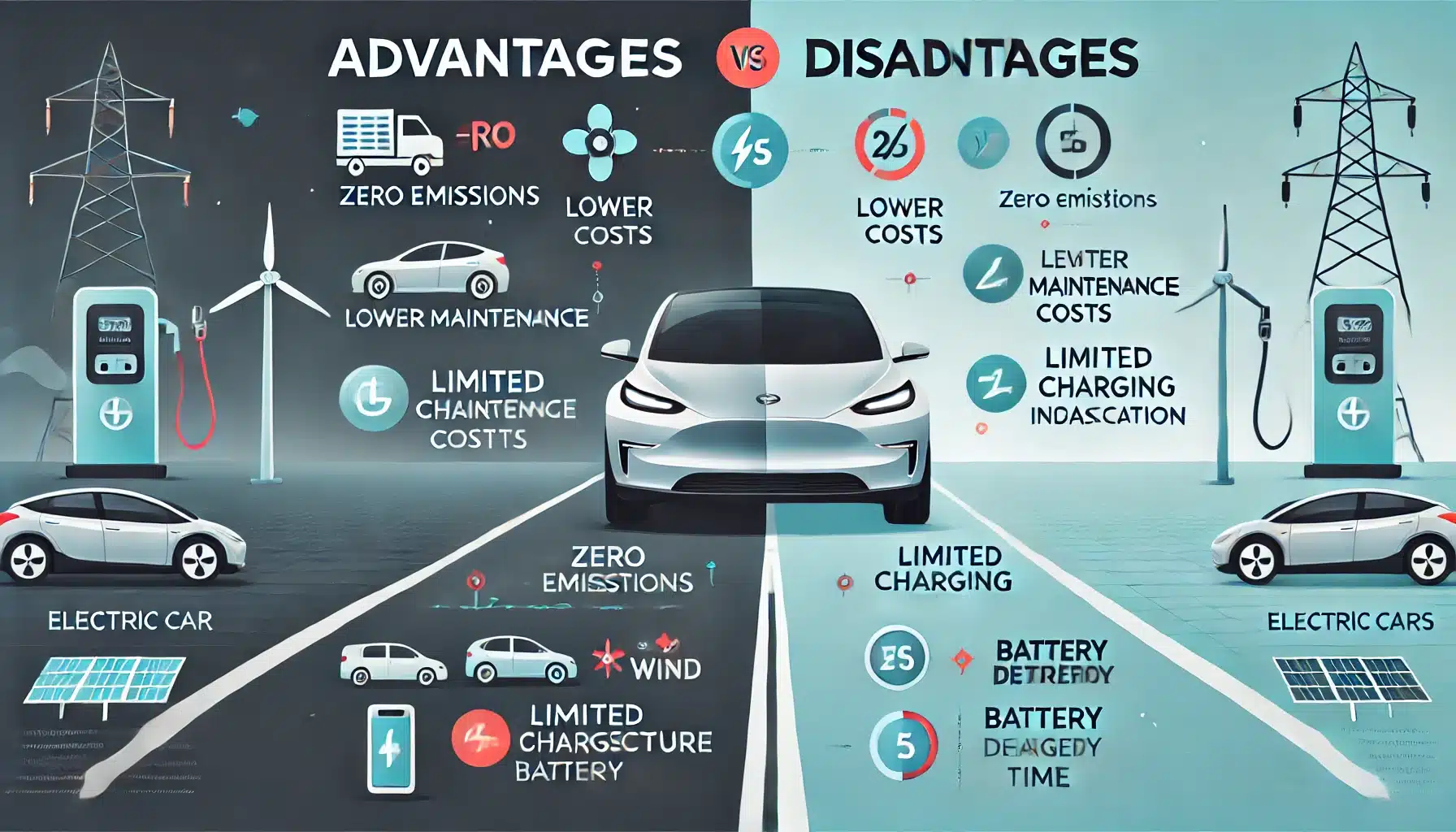Below is a comprehensive analysis of the advantages and disadvantages of electric cars (EVs). These points reflect the current state of EV technology, market availability, and consumer experiences. They are expected to continue evolving as technology and infrastructure improve.
Advantages
1. Environmental Benefits
- Reduced Emissions: Electric vehicles emit no tailpipe pollutants, significantly cutting carbon emissions and improving local air quality (especially important in urban areas).
- Energy Efficiency: EVs are more energy-efficient than internal combustion engine vehicles (ICEVs). They convert a higher percentage of electrical energy from the grid to power at the wheels.
- Potential for Clean Energy Integration: When charged using electricity generated from renewables (solar, wind, hydro), the overall carbon footprint can be drastically lower than that of gasoline or diesel vehicles.
2. Lower Operating Costs
- Cheaper Fuel: Electricity is generally cheaper than gasoline or diesel per mile driven. Savings vary by region and electricity tariffs but tend to be substantial over the vehicle’s lifetime.
- Reduced Maintenance: EVs have fewer moving parts (no engine oil, fewer fluids, no exhaust system), leading to lower maintenance and repair costs. Brake wear is also reduced by regenerative braking systems.
3. Improved Performance
- Instant Torque: Electric motors deliver power instantly, resulting in rapid acceleration. Many EVs have competitive 0–60 mph times compared to sports cars.
- Quiet Operation: Electric motors are quieter than internal combustion engines, improving the driving experience and reducing noise pollution.
4. Government Incentives
- Tax Credits and Rebates: Many governments offer financial incentives such as tax credits, rebates, and reduced registration fees to encourage EV adoption.
- Access to Restricted Areas and Perks: In some areas, EV drivers get benefits like free or discounted parking, toll reductions, or permission to use high-occupancy vehicle (HOV) lanes.
5. Technological Growth and Innovation
- Continuous Advancements: Battery technology is rapidly improving, leading to longer ranges, faster charging, and lower costs over time.
- Software Upgrades: Many EVs receive over-the-air updates that can enhance performance, add features, or improve battery efficiency without requiring a physical service visit.
Disadvantages
1. Higher Upfront Cost
- Purchase Price: Despite lower running costs, the initial purchase price of many electric cars can still be higher than comparable ICEVs.
- Battery Expense: The battery pack is a significant portion of an EV’s cost. Although battery prices are falling, they remain a considerable component of the total vehicle price.
2. Limited Range (Compared to ICEVs)
- Range Anxiety: Some consumers worry about running out of charge, especially on longer trips. While modern EVs can often travel 200–300 miles (or more) on a single charge, this may still be less than the typical range of gas-powered cars.
- Cold Weather Effects: EV ranges can decline in extreme temperatures, due to increased battery heating or cooling needs.
3. Charging Infrastructure and Time
- Infrastructure Gaps: Although charging stations are growing in number, they are not yet as ubiquitous or convenient as gas stations, especially in rural or less developed areas.
- Longer Refueling Times: Fast-charging can take 20–45 minutes to reach ~80% capacity, whereas a gasoline car can typically refuel in minutes. Level 2 home chargers or public chargers can take several hours for a full charge.
4. Battery Degradation
- Limited Lifespan: Over time, batteries lose some capacity. Most EVs have warranties (often 8 years or 100,000 miles), but replacement costs can be high if needed outside warranty.
- Resale Uncertainty: Potential buyers might worry about the remaining useful life of the battery, affecting used EV resale values in some markets.
5. Resource and Supply Chain Concerns
- Rare Earth Metals: EV batteries often rely on materials like lithium, cobalt, and nickel. Mining and refining these can have environmental and ethical implications.
- Manufacturing Footprint: While EVs excel in reduced tailpipe emissions, the manufacturing process, including battery production, can be carbon-intensive if powered by non-renewable energy sources.
Balancing the Pros and Cons
- Cost vs. Savings: While EVs can be more expensive upfront, they can offer significant savings in fuel and maintenance over time. Government incentives can also help offset the initial cost.
- Range and Infrastructure Progress: Each new generation of EVs tends to offer longer ranges, and charging networks are expanding rapidly in many countries. Fast-charging technologies continue to improve, reducing charging times.
- Technology Evolution: With global investments flowing into battery research, we can expect better energy density, faster charging, and lower costs—improving the overall value proposition of EVs.
- Environmental Considerations: EVs already have an edge in reducing direct vehicle emissions. As grids incorporate more renewable energy, the environmental benefits of electric cars will further increase.
Conclusion
Electric cars present compelling advantages in terms of lower emissions, reduced running costs, and overall performance improvements. However, challenges remain around upfront cost, range limitations, charging infrastructure, and battery sustainability. Government incentives, advances in battery technology, and expanding charging networks are steadily addressing these issues. As technology continues to evolve and economies of scale develop, electric vehicles are likely to become an increasingly practical and eco-friendly choice for a broader range of consumers.


